Home gardeners know the struggle all too well. The season has shifted, frost is around the corner, and your beloved tomato plants are still dotted with green fruit. But don’t worry—there’s no need to say goodbye to your harvest.
Green tomatoes can ripen beautifully indoors with the right technique, ensuring you enjoy their full flavor without letting them go to waste. Whether you’re dealing with an unexpected cold snap or simply want to speed up the ripening process, learning how to ripen green tomatoes indoors can make all the difference.
By using proven methods such as paper bag ripening, box storage, or placing tomatoes near ripe fruit, you can control the process and achieve the best results. This guide will walk you through the simple and effective steps to ripen green tomatoes indoors, complete with tips, tricks, and common pitfalls to avoid.
Whether you’re an avid gardener, an urban farmer, or a cooking enthusiast, you’ll find everything you need to rescue your green tomatoes and transform them into ripe, delicious gems—ready for your favorite recipes.
Why Do Tomatoes Stay Green on the Vine?
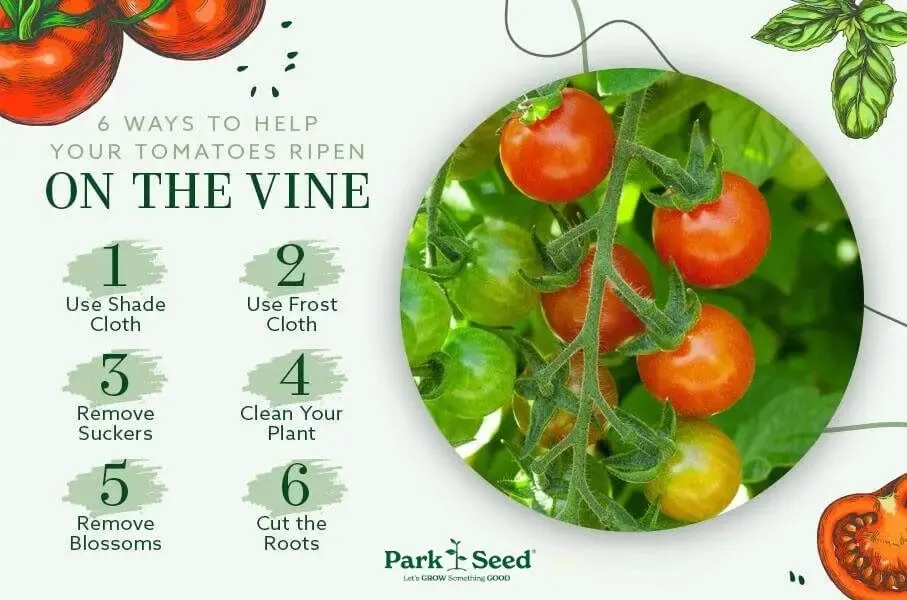
Before we jump into indoor ripening methods, it’s important to understand why tomatoes sometimes don’t ripen on the vine. Several factors can come into play, including temperature, sunlight levels, and the tomato plant’s growing stage.
Tomatoes need warmth to ripen—ideally, temperatures between 70°F and 85°F. When temperatures drop below 55°F, the ripening process slows significantly, and in many cases, halts altogether. Additionally, shorter daylight hours during the end of the growing season can interfere with the production of ethylene gas, the natural plant hormone responsible for turning tomatoes red.
Other factors, such as overcrowding on the vine or excessive nitrogen in the soil, can also delay ripening. While it’s frustrating to see green tomatoes lingering on the vine as the season changes, all hope isn’t lost. Thankfully, even if conditions outdoors aren’t cooperating, you can ripen green tomatoes indoors using simple and effective techniques.
With the right approach, you can mimic the natural ripening process and enjoy homegrown tomatoes long after the outdoor growing season ends.
The Basics of Ripening Tomatoes Indoors
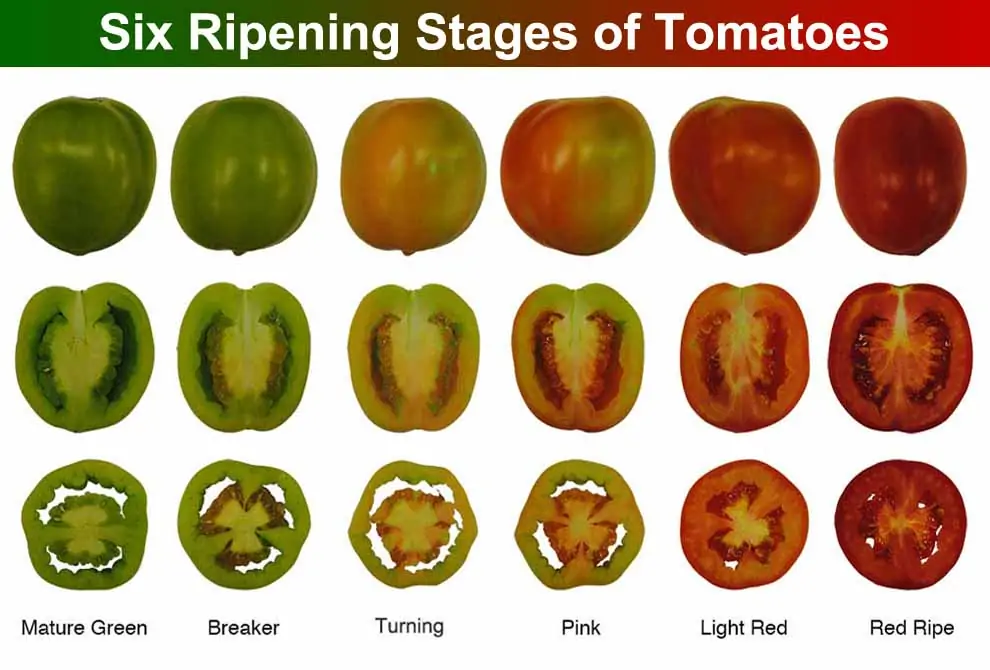
The good news? Tomatoes don’t need to stay attached to their plants to ripen. By providing them with a warm, ethylene-rich environment, you can coax those green tomatoes to maturity. Whether you’re dealing with an early frost or an end-of-season surplus, understanding the key principles will help you achieve the best results.
Core Principles for Ripening Success
- Harvest Just Right: Select green tomatoes that are mature. Look for ones that have reached their full size and show a faint blush of color or a slightly waxy sheen. These have already begun the ripening process and will turn red more easily.
- Avoid Damaged Fruit: Tomatoes with cracks, bruises, or disease spots won’t ripen properly and may spoil quickly. Always start with firm, healthy fruits to ensure the best results.
- Create Ideal Conditions: Tomatoes ripen best in warm temperatures of around 70°F to 75°F. They also need proper airflow to prevent excess moisture buildup, which can lead to mold or rot. Keeping them in a well-ventilated area enhances the ripening process.
- Encourage Ethylene Exposure: Ethylene gas naturally speeds up ripening. Placing green tomatoes near ripe bananas, apples, or even other ripening tomatoes can help accelerate the process.
By following these simple principles, you can successfully ripen green tomatoes indoors and enjoy flavorful, homegrown produce even after the outdoor growing season has ended. Now, let’s explore the best methods to get the job done!
Step-by-Step Methods to Ripen Green Tomatoes Indoors
1. Ripen Tomatoes in a Paper Bag
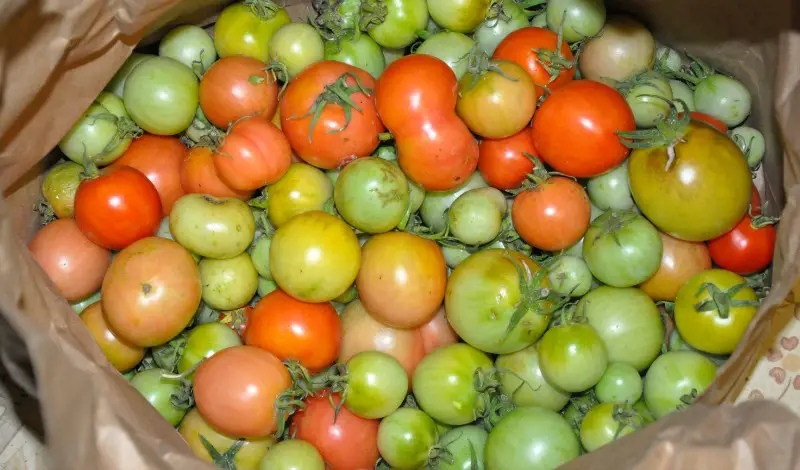
A simple paper bag may seem basic, but it’s one of the most effective tools for ripening green tomatoes indoors. This method traps ethylene gas while still allowing airflow, creating the perfect environment for tomatoes to turn red.
How to Ripen Tomatoes in a Paper Bag:
- Select the Right Tomatoes: Choose mature green tomatoes that are firm and free of blemishes or cracks.
- Use a Brown Paper Bag: Place a small number of tomatoes inside a brown paper bag—too many can lead to excess moisture buildup.
- Add a Ripe Banana or Apple: These fruits naturally emit ethylene gas, which speeds up the ripening process.
- Close the Bag Loosely: Roll the top of the bag to trap ethylene while still allowing for some airflow.
- Store in a Warm, Dry Spot: Keep the bag in a location where temperatures stay around 70°F to 75°F, such as a countertop or pantry.
- Check Daily: Inspect the tomatoes regularly for ripeness and remove any that have softened too much or started to spoil.
Why It Works:
The ethylene gas from the banana or apple creates a micro-environment that encourages ripening. The paper bag also prevents excessive moisture buildup, reducing the risk of mold or rot. By monitoring the tomatoes daily, you can ensure they ripen evenly and stay fresh.
This simple method is an excellent way to ripen green tomatoes indoors quickly and efficiently, allowing you to enjoy delicious, homegrown produce even after the outdoor season ends!
2. Ripen Tomatoes in a Cardboard Box
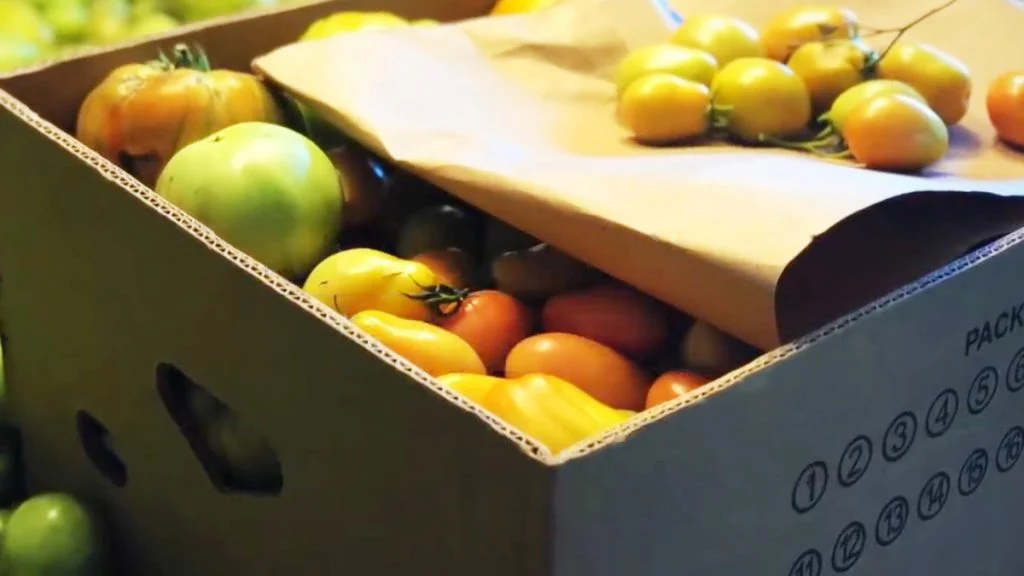
If you have a large number of green tomatoes, using a cardboard box is a great way to ripen green tomatoes indoors efficiently. This method provides a stable, breathable environment while preventing excess moisture buildup.
How to Ripen Tomatoes in a Cardboard Box:
- Prepare the Box: Line a shallow cardboard box with newspaper or paper towels to cushion the tomatoes and absorb moisture.
- Arrange the Tomatoes: Place green tomatoes in a single layer with some space between them to allow airflow and prevent bruising.
- Add a Ripe Banana or Apple: These fruits naturally release ethylene gas, which speeds up the ripening process.
- Cover with Newspaper or a Breathable Cloth: This helps trap ethylene while still allowing air circulation to prevent mold growth.
- Store in a Warm Spot: Keep the box in a room with temperatures around 70°F to 75°F. Avoid damp or cold areas, as these can slow down the ripening process.
- Check Every Few Days: Inspect the tomatoes for ripeness, removing any that have softened or started to spoil to keep the rest fresh.
Pro Tip:
Cardboard absorbs excess moisture, reducing the risk of mold and rot. If you’re ripening a large batch, consider using multiple small boxes rather than one deep container to maintain good airflow.
This method is perfect for gardeners with an abundance of green tomatoes, ensuring they ripen evenly and remain in great condition for fresh eating or cooking!
Related Topics:
3. Ripen Tomatoes on a Windowsill
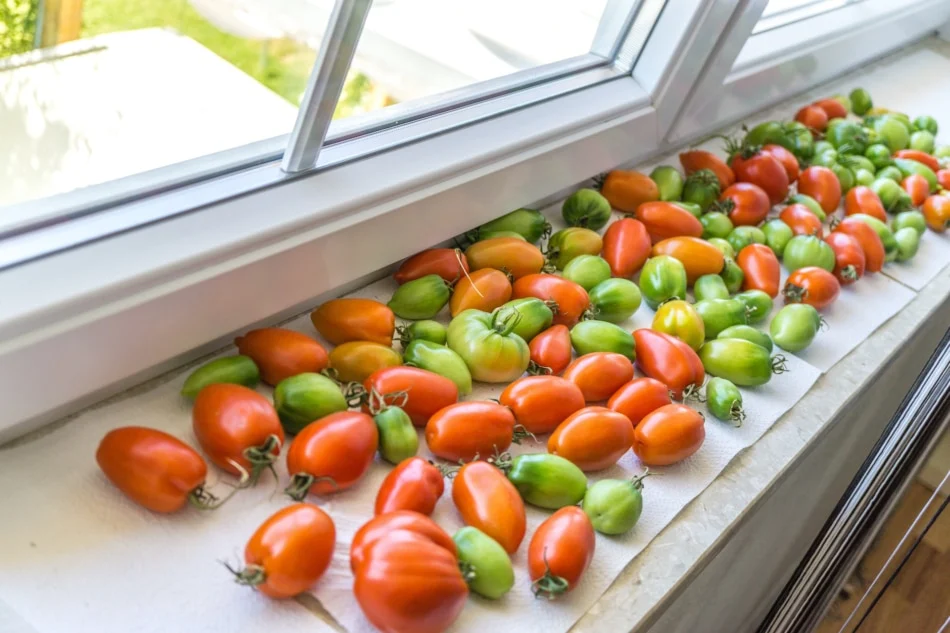
If your green tomatoes have already started to show a slight blush, simply placing them on a windowsill can help them ripen naturally. This method is easy, requires no extra materials, and works well for a small batch of tomatoes.
How to Ripen Tomatoes on a Windowsill:
- Wash and Dry the Tomatoes: Gently clean the tomatoes to remove dirt or any bacterial residue that could cause spoilage.
- Choose the Right Spot: Place the tomatoes on a windowsill where they will receive indirect sunlight. A bright but shaded area works best.
- Turn Them Daily: Rotate the tomatoes each day to ensure they ripen evenly and don’t develop soft spots on one side.
- Monitor for Overexposure: Avoid placing them in direct, intense sunlight for extended periods, as this can cause overheating, uneven ripening, or wrinkling of the skin.
Keep in Mind:
This method is ideal for tomatoes that have already begun the ripening process. However, if your tomatoes are still completely green, using an ethylene-producing method—like a paper bag or cardboard box—will likely be more effective.
By using the right approach, you can ripen green tomatoes indoors without hassle, ensuring they develop full flavor and a perfect texture!
4. Hang Them Upside Down

If you’ve had to pull your tomato plants out of the ground before the fruit fully ripened, don’t discard them just yet! You can ripen green tomatoes indoors by hanging the entire plant upside down, allowing the fruit to ripen gradually while still attached to the vine.
How to Ripen Tomatoes by Hanging the Plant:
- Shake Off Excess Soil: Gently remove loose soil from the roots, but avoid washing them to prevent excess moisture.
- Find a Suitable Space: Choose a cool, dark room with good airflow, such as a basement, garage, or shed. The ideal temperature is around 60°F to 70°F.
- Hang the Plants Upside Down: Secure the plants by their root systems and hang them upside down from hooks, beams, or sturdy nails.
- Monitor the Ripening Process: Over time, the tomatoes will slowly ripen using the nutrients still stored in the plant. Check them regularly and pick the ripened ones as needed.
Why It Works:
This method mimics natural vine-ripening and is especially effective for heirloom or vine-ripened tomato varieties, which tend to retain their flavor even after being uprooted. The plant continues supplying nutrients to the fruit, resulting in tomatoes with richer taste and texture.
If you’re looking for a hands-off way to ripen green tomatoes indoors, this technique is perfect for larger harvests while preserving homegrown flavor!
5. Use a Ripening Dome
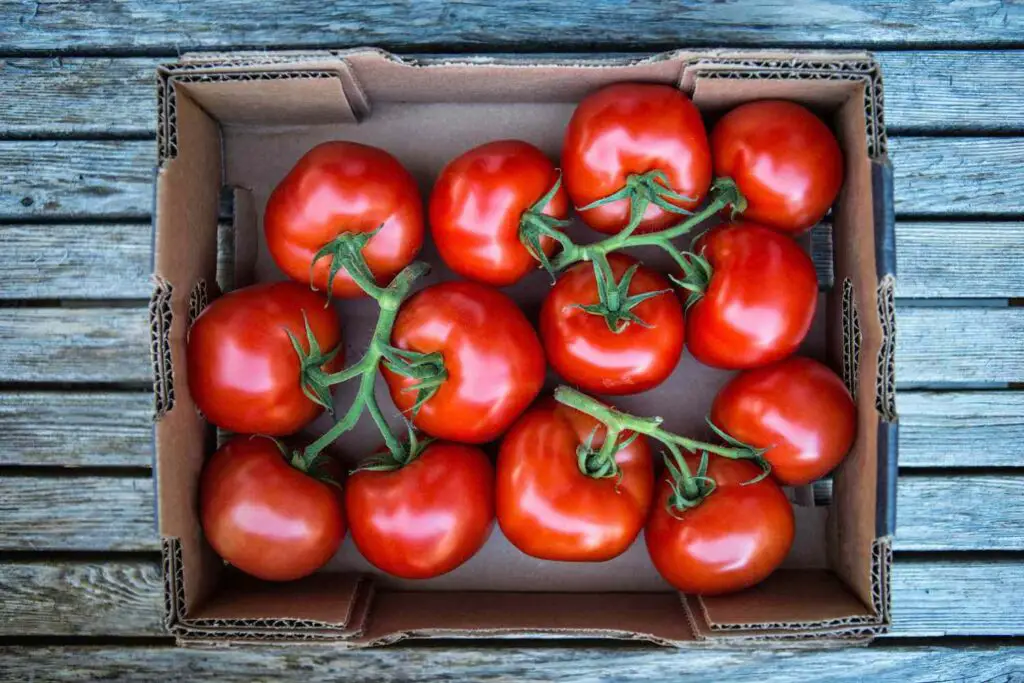
For a high-tech and controlled approach, a ripening dome can provide the perfect environment to ripen green tomatoes indoors efficiently. These specialized containers regulate temperature, humidity, and ethylene concentration to speed up and optimize the ripening process.
How to Ripen Tomatoes Using a Ripening Dome:
- Place Green Tomatoes Inside the Dome: Arrange the tomatoes inside the container, ensuring they have enough space for air circulation.
- Follow Manufacturer’s Instructions: Each ripening dome operates differently, so be sure to adjust the settings according to the recommendations for optimal results.
- Monitor the Progress: Check the tomatoes daily and remove any that have fully ripened to prevent overripening.
Why It Works:
A ripening dome creates a controlled micro-environment, ensuring consistent warmth and ethylene exposure while preventing excess moisture buildup that can lead to rot. While this method requires an upfront investment, it’s ideal for those who frequently ripen tomatoes or want a fast, predictable, and hassle-free solution.
If you’re serious about efficiency, a ripening dome offers a modern, hands-off way to enjoy perfectly ripened homegrown tomatoes!
Common Mistakes to Avoid
Even with the most effective method, certain mistakes can get in the way of success when trying to ripen green tomatoes indoors. To ensure your tomatoes turn red and develop full flavor, be mindful of these common pitfalls:
- Too Much Moisture: Without proper airflow, excess moisture can build up, leading to mold and rot. Always use breathable materials like paper bags, newspaper, or cardboard, and store tomatoes in a dry environment.
- Overcrowding: Packing too many tomatoes together can trap humidity and encourage spoilage. Arrange them in a single layer with space in between to allow even ripening.
- Picking Extremely Green Tomatoes: If tomatoes are harvested too early, they may not contain enough natural sugars to ripen properly. For the best results, select mature green tomatoes with a slight blush or a waxy sheen.
- Exposure to Direct Sunlight for Too Long: While a windowsill can help ripen slightly blushed tomatoes, excessive direct sunlight can cause overheating, wrinkling, or uneven ripening. Choose a bright but indirectly lit spot instead.
By avoiding these pitfalls, you’ll significantly increase your chances of enjoying perfectly ripe, homegrown tomatoes—no matter the season!
What to Do with Semi-Ripe Tomatoes
If your tomatoes seem to stall halfway through the ripening process, don’t panic! Semi-ripe tomatoes—those that are starting to turn color but haven’t fully ripened—can still be delicious and versatile in the kitchen. Instead of waiting endlessly, try these creative ways to use them:
- Make a Savory Sauce: Semi-ripe tomatoes add a unique tangy-sweet balance to pasta sauces, soups, and stews. Cook them down with garlic, onions, and herbs for a rich flavor.
- Try Fried Green Tomatoes: If your tomatoes are still mostly green, slice them up, coat them in cornmeal, and fry them for a crispy, Southern-style treat.
- Roast for a Flavor Boost: Roasting semi-ripe tomatoes caramelizes their natural sugars, bringing out a deep, rich taste perfect for sandwiches, salads, or pasta.
- Blend into a Chutney or Relish: Puree semi-ripe tomatoes with vinegar, spices, and sugar to make a tangy chutney that pairs well with cheese, meats, or grilled veggies.
- Pickle Them: Preserve the tartness of semi-ripe tomatoes by pickling them with vinegar, garlic, and spices for a zesty snack or condiment.
No matter how you use them, semi-ripe tomatoes offer a delicious and creative way to enjoy your harvest, even if they don’t fully ripen!
Ripening green tomatoes indoors doesn’t just save your harvest—it’s a rewarding way to connect with your food and make the most of your homegrown produce. By using these tried-and-true ripening methods, you can extend your gardening season and enjoy delicious, vine-ripened flavor, no matter the weather.
Whether you have a few green tomatoes or a full harvest, these simple techniques will help you ripen them efficiently and reduce food waste in the process. Plus, by taking control of the ripening process, you ensure your tomatoes develop the best possible taste and texture.
Want more expert tips on gardening and food preservation? Subscribe to our newsletter for practical advice, seasonal gardening insights, and creative recipes. Start ripening your tomatoes today and enjoy the flavors of summer—any time of year!
FAQs:
1. How long does it take to ripen green tomatoes indoors?
The ripening process typically takes 5 to 14 days, depending on the method used and how mature the tomatoes are when picked. Warmer temperatures (around 70°F to 75°F) and ethylene exposure (from ripe bananas or apples) can speed up the process.
2. Can I ripen green tomatoes in the refrigerator?
No, refrigerating green tomatoes slows down or even stops the ripening process. Cold temperatures below 55°F can cause tomatoes to lose flavor and develop a mealy texture. It’s best to ripen them at room temperature using methods like a paper bag, cardboard box, or windowsill.
3. Will all green tomatoes eventually turn red indoors?
Not always. Tomatoes that are too immature (small, hard, and bright green) may not have developed enough natural sugars and compounds to ripen properly. For the best results, pick mature green tomatoes that are full-sized and have a slight color change or waxy sheen.
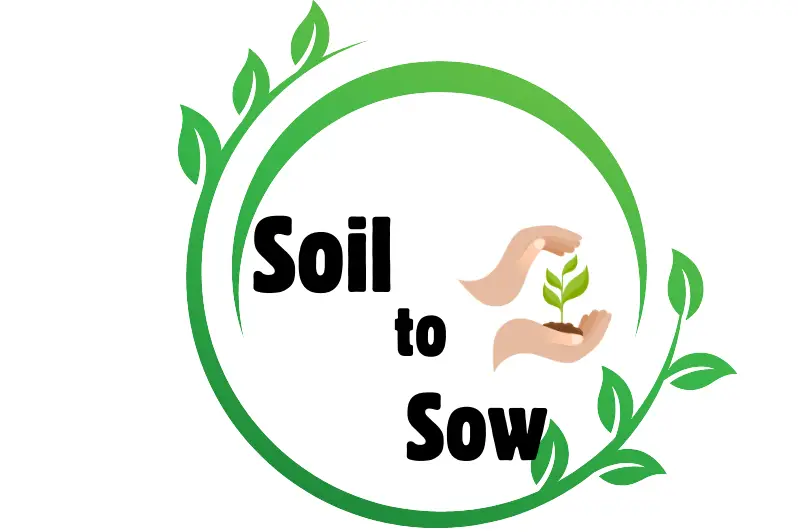
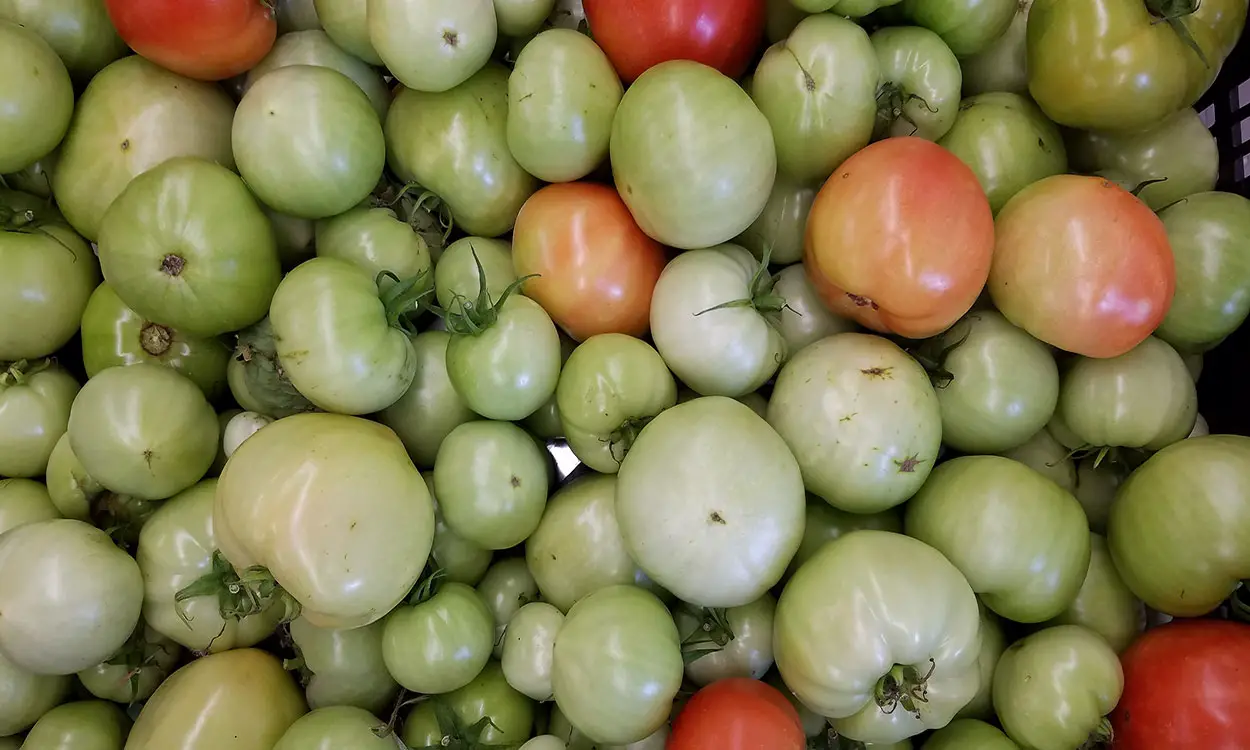
2 thoughts on “How To Ripen Green Tomatoes Indoors: Fast & Easy Methods!”